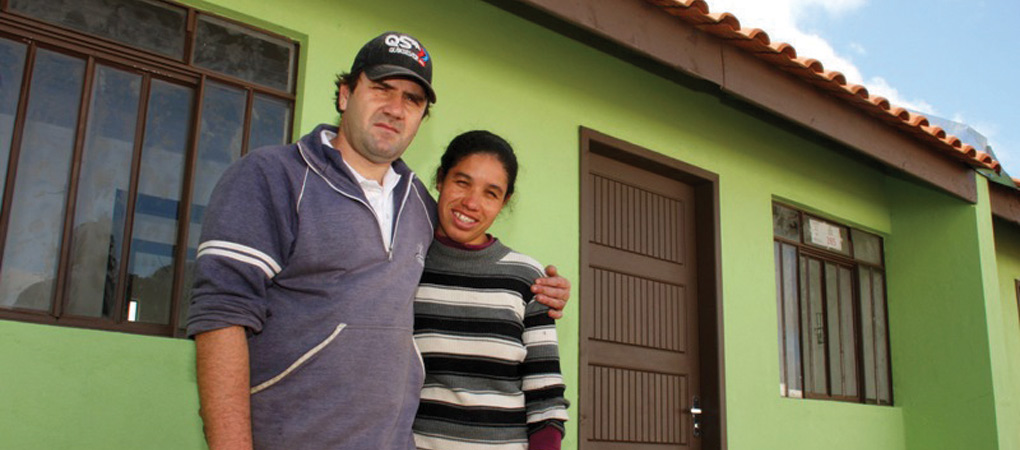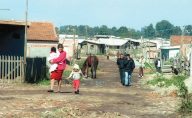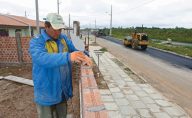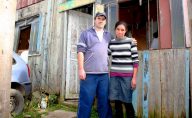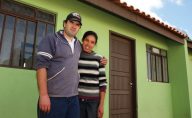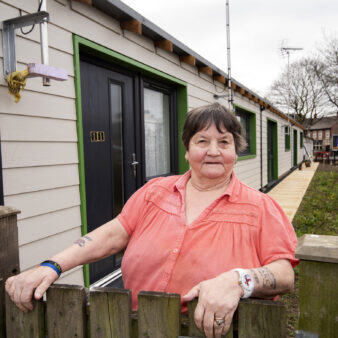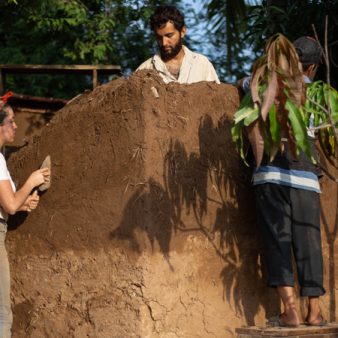This upgrading project has been carried out in Audi União, one of largest and poorest squatter settlements in Curitiba, Brazil. The project has protected the households living in high-risk areas on the banks of the Iguaçu river, it provides safer and improved living conditions whilst avoiding evictions and ensuring that families are able to stay within the same community. It has developed an integrated multidisciplinary and participatory approach involving partnerships between the local community, local leaders, civil society organisations and government agencies at local, state and national levels.
Project Description
What are its aims and objectives?
The main purpose of the project is the protection of households living in high-risk areas on the banks of the Iguaçu river in Audi União shantytown. The project includes the improvement and/or provision of urban infrastructure (drainage systems, sanitation and flood control measures); housing within the local area for families living in high-risk areas, including one-, two- and three-bedroom units; recovery of areas of environmental protection; the regularisation of land tenure and social programmes contributing to safety and security, urban mobility, gender equality and social inclusion. Investments have also been made in the construction and improvement of public health, education, culture, sports and leisure facilities. Residents have been involved throughout the process through partnerships established between government agencies and local residents’ associations. The project has improved homes without resettlement and has only resettled those people who were at risk from flooding or landslides.
What context does it operate in?
Curitiba is one of the fastest growing cities in Brazil, with a municipal population of 1.8 million people. The city is known for a number of innovative initiatives to improve the local environment. Audi União informal settlement is home to 3,144 low-income families, many of whom were previously living in precarious conditions in an area of environmental protection on the banks of the Iguaçu river – an area which is prone to frequent and devastating floods. It is the largest and poorest informal settlement in the city of Curitiba, with 70 per cent of households earning less than the minimum wage and 86.5 per cent of households lacking adequate water supply, electricity, waste collection and drainage systems. With one of the highest homicide rates in the city, residents of Audi União face conditions of insecurity and vulnerability. Many of the houses are built on stilts and are constructed using poor quality building materials. The project has been implemented by Curitiba Municipal Housing Company (COHAB/CT), a public housing institution, established in 1965 to provide housing for low-income households in the city of Curitiba. Its activities are carried out with funding from local and national government sources as well as through public-private partnerships. COHAB/CT implements Federal Government housing programmes as well as programmes for urban and informal settlement upgrading.
What are its key features?
This comprehensive informal settlement upgrading project has been carried out in Audi União through an integrated, multidisciplinary and participatory approach involving partnerships between the local community, local leaders, civil society organisations and government agencies at local, state and national levels. Residents, through partnerships established between government agencies and local residents’ associations, have been involved throughout the process. The project includes the improvement and/or provision of urban infrastructure and services. Investments have also been made in the construction and improvement of public health, education, culture, sports and leisure facilities. New housing is provided to the families living in high risk areas and land tenure has been regularised. Social programmes contributing to safety and security, urban mobility, gender equality and social inclusion have been introduced. Flood control measures, though still ongoing, have led to a significant decrease in flooding in the area.
How is it funded?
Total funding amounting to US$19.5 million (R$38 million) has been provided by the CAIXA Federal Savings Bank (67.2 per cent) and by the Curitiba Municipality (32.8 per cent), covering the following areas: a) flood control; b) recovery of areas of environmental protection; c) construction and refurbishment of housing; d) land tenure regularisation; e) urban upgrading; f) social inclusion. In addition, the Municipality has invested in the construction and improvement of public facilities relating to health, education, culture and sports, as well as collaborating with the state government of Paraná on the provision of public security and leisure facilities.
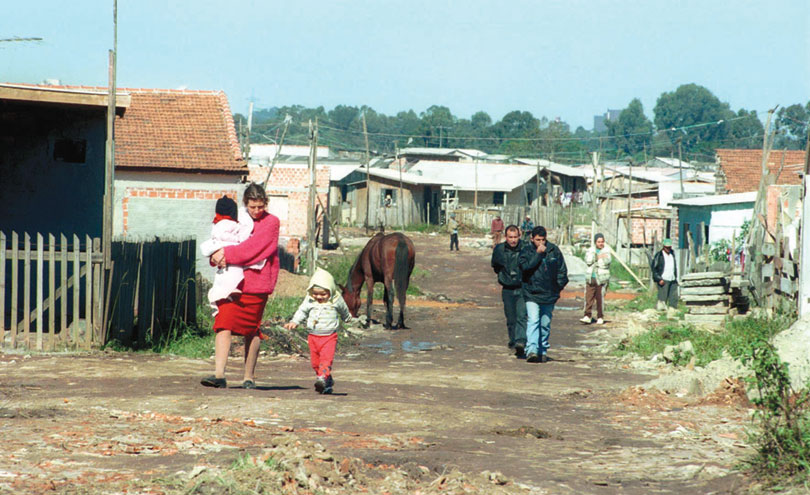
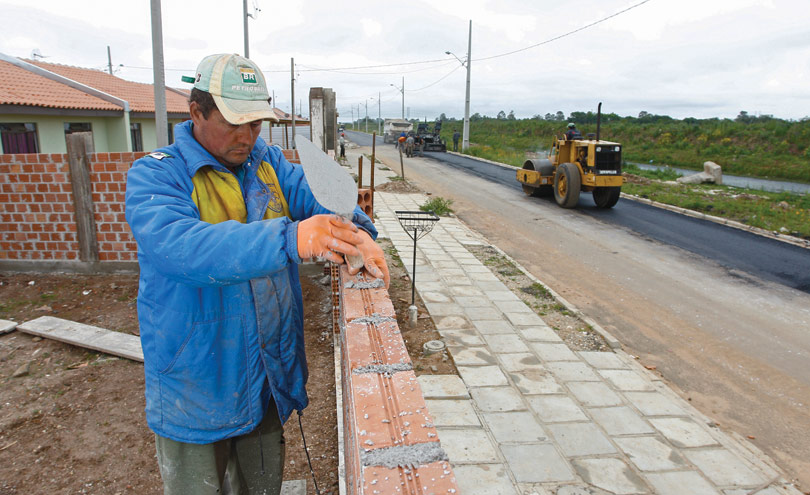
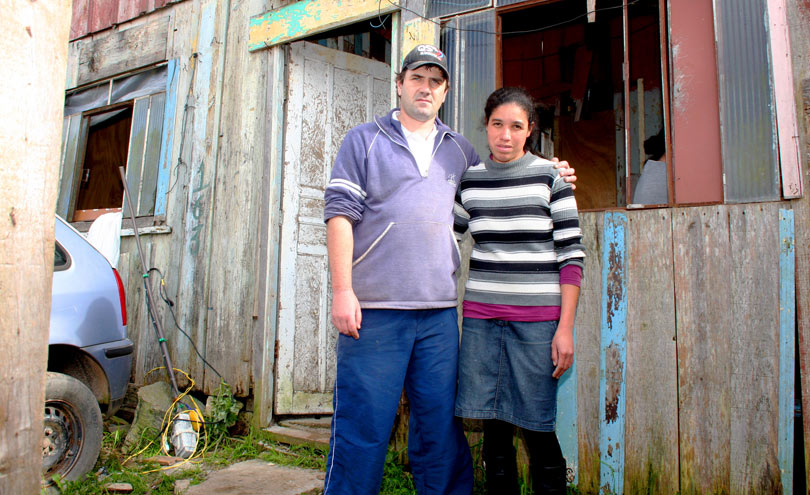
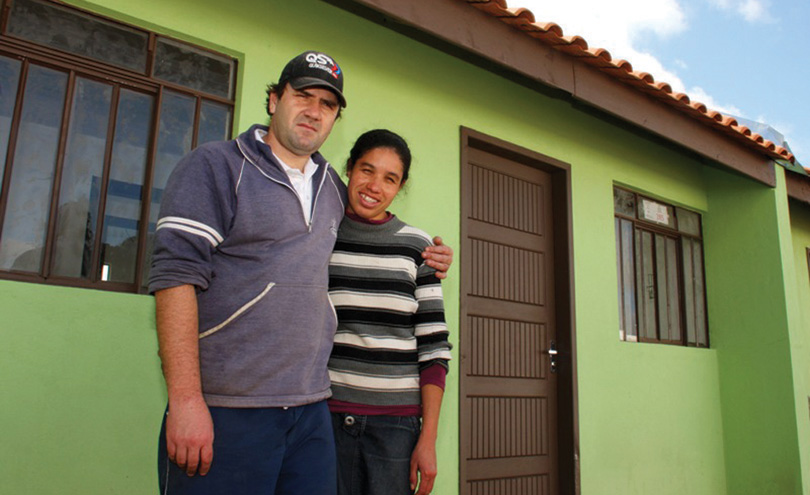
What impact has it had?
The project has made significant improvements in the living conditions of residents, including flood risk reduction, increased security and improved sanitation and environmental conditions within the community and surrounding areas. Following the implementation of the flood prevention system, there has not been any subsequent flooding in the area, despite heavy rains and flooding in surrounding areas not covered by the project. Income levels have increased, with a 206 per cent increase in the number of families earning at least the minimum wage. There has been a reduction of 33 per cent in the number of violent deaths and 26 per cent in the number of armed robberies. Urban mobility has been improved through a range of actions, including the paving and widening of streets, public lighting, improved public transport (with 20 additional bus lines), selective waste collection and formal address registration. Residents have since been involved in carrying out improvements to their housing and there has been a gradual change in habits and in the relationship of residents with public/communal spaces.
Why is it innovative?
- Integrated, multidisciplinary approach, including three levels of government, carried out through partnerships between a range of actors and levels of government. The complexity of the issues to be addressed required common goals, participatory planning and integrated actions that are environmentally responsible and socially just, with community members involved throughout the process.
- Ensuring that families were relocated only where necessary and not more than 500 metres from their original homes, respecting community and neighbourhood ties. The conventional solution might have been a full or partial resettlement of the area, as it involves the occupation of an area of environmental protection, subject to flooding. This solution addressed the environmental problems whilst ensuring that all residents were able to remain in their community, avoiding the demolition of thousands of homes built with the efforts and financial resources of the community.
- Going beyond physical improvements, establishing effective communication channels between community residents and government, addressing gender issues (particularly around land titling) and working to ensure the right to adequate housing.
What is the environmental impact?
The project has used conventional building materials, many of which are locally sourced, for the construction of the new housing units.
It has kept existing housing and communal buildings except in the areas of highest risk, making use of existing resources.
The project involves the provision of adequate water supply, sanitation, waste collection and drainage infrastructure, which was previously not in place in the Audi União settlement. A macro-drainage system has been built to address the issues of intense flooding in the area as well as delineating the boundaries of the settlement and areas of environmental preservation, with the overall aim of reducing risk to people and the environment. No flooding has been recorded in the area following implementation, despite heavy rains.
Is it financially sustainable?
The project has been carried out with funding from both federal and municipal government sources and in partnership with a range of other organisations and public service providers. In other projects, where similar levels of state funding were not available, COHAB/CT has obtained funding for its work through public-private partnerships.
The project has supported skills development to enhance local family incomes.
A range of training courses and activities focussing on income generation and employment were carried out within the community and by 2010 there had been a 206 per cent increase in the number of families earning at least the minimum wage. In addition, the fact that residents have been able to remain in their community rather than being resettled in distant areas has ensured that existing employment and access to places of work have not been affected.
What is the social impact?
The project approach demonstrates the strong commitment of all actors involved and has facilitated greater cooperation both within the community and amongst different government agencies and institutional partners. Local NGOs have played a key role in facilitating collaboration and the project has worked to foster a sense of belonging, confidence, permanence and continuity within the community, resulting in the strengthening of social ties and maintenance of existing relationships and networks.
The project works with highly-vulnerable families and seeks to implement strategies that oppose social exclusion and lead to a reduction in social inequalities. Women in particular have benefited from the project, particularly with regards to the land tenure regularisation/titling process where priority is given to women heads of household.
The project has worked to improve access to rights and information, promote citizenship and empower communities. Residents now pay government-subsidised utility bills and formalising property ownership, improving urban mobility and ensuring access to public infrastructure and services have all contributed towards enabling residents to take a more active role in society.
Barriers
- From the outset, the problems faced were complex and required integrated and multidisciplinary solutions. COHAB/CT has worked in partnership with the community and a range of local organisations to address these issues in an integrated way.
- Due to financial constraints, the original project did not include the construction of public health and educational facilities and there is a demand for schools and health units in the area, as well as leisure and recreational facilities. This has affected children and young people in particular, and the gap has been partially filled through the application of municipal resources in the construction of a municipal nursery, a youth centre, health units and a centre for social assistance.
- Although there has been a significant improvement in living conditions and quality of life for residents, a few key issues still remain, including safe access to rail transportation and improved connections to the sewage disposal system, which is in the process of being carried out through another project.
Lessons Learned
- During the implementation of the project, it was found that the problems arising from informal settlements in areas of environmental preservation affected the city as a whole, causing social, economic, physical and environmental damage.
- Partnership working was essential, as the complex problems faced cannot be fully resolved by a single institution or group of people. The establishment of strong partnerships enabled discussions to take place based on the specific conditions in the area, as well as making it possible for government actions to go beyond purely physical interventions.
- In order to establish these partnerships it is important to recognise the importance of engaging the three levels of government (federal, state and local), the various sectors within the municipal government and relevant organisations, local groups and professionals engaged in the pursuit of access to social rights, public goods and services.
- In order to ensure a successful outcome, it is important to establish direct links between communities and government through a participatory approach, increased access to information and improved communication channels. It is recognised that a strong partnership between the community and government is critical to effectively guarantee the rights of citizens and the development of a sense of appreciation and belonging amongst residents.
- Integrated actions in urban upgrading and infrastructure provision should be carried out in accordance with public policies relating to housing, sanitation, social support, health, education and the environment.
Evaluation
Monthly reports are produced on the activities carried out by the social assistance team, as well as gathering data on the housing units and other urban and physical intervention processes. The multidisciplinary team carrying out the project meets each month in order to strengthen communication and monitor the work that has been completed. A range of indicators have been developed for post-occupancy monitoring and evaluation with funding provided by the Brazilian Ministry of Cities, in order to give visibility to the results, impacts and level of satisfaction of the local community, as well as providing an opportunity to reflect on the implementation process and the effectiveness of the results achieved. A final research project is due to be carried out on the project encompassing three key areas:
- Housing and Urban Environment: including basic infrastructure, urban mobility, environmental quality and housing.
- Social Inclusion: focussing on access to public services (education, health, sport, leisure, culture, social assistance and public security), citizenship and participation and job market insertion.
- Household Satisfaction: capturing the evaluation of local residents regarding their own housing conditions, urban infrastructure and services, as well as looking at the impact of the project on social and community life.
Transfer
The approach is currently being scaled up by COHAB/CT and is being applied in 64 active projects in the city of Curitiba in areas that, as in the case of Audi União, require integrated actions. In each case the approach is being adapted to local specificities and complexities.
Although there has not been any national or international transfer of the approach as yet, there has been a great deal of interest in the project and Audi União has received a number of national and international visitors, including the United States Secretary of Housing and Urban Development, Shaun Donovan.

